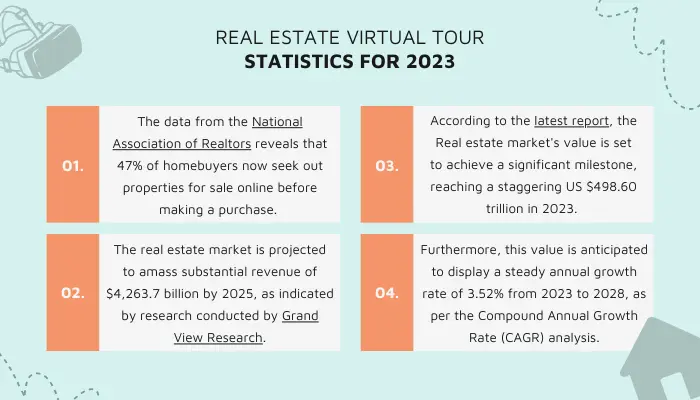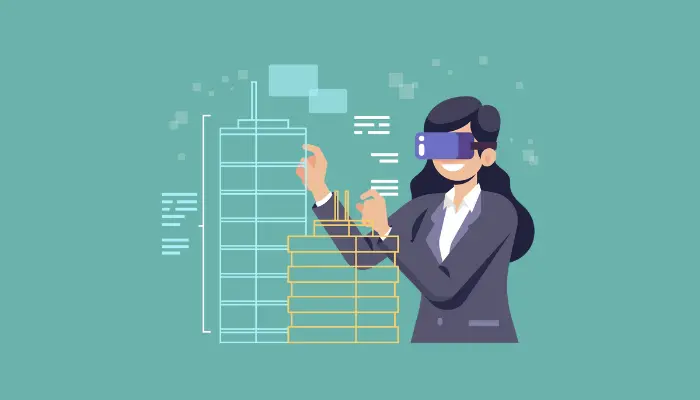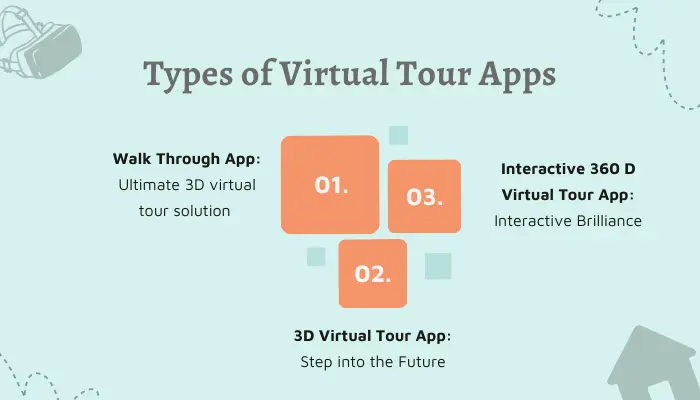MatterpotTechnological advancements have created a buzz in every industry. Virtual tour real estate apps in the real estate industry become popular. This industry has gained a major boost by integrating IT.
Today, clients can get a virtual tour of the house before signing a document, this became possible because of virtual reality. With this technology, one can render a building plan in 3D and the client can easily interact with digital space using a headset.
Moreover, without being present on sites, clients can view properties and create a list of better properties. In 2023, the global virtual tour software market will grown from USD 384 m to USD 941m by 2030. And increase with a CAGR of 13.7% during the forecast period.
This shows, a tremendous boost in the real estate niche, but many real estate agents avoid creating virtual tours because they lack time, effort, and money.
Adapting and staying up to date with the latest technology trends is very important to remain on the competitive edge. If you are planning to create a virtual tour Real estate app, we guide you through the process, keep reading.
Major fortunes in America have been made in land.” – John D. Rockefeller
Real Estate Virtual Tour Statistics For 2023

What is better than getting a virtual tour of the property without spending time visiting that place in real-time? Let’s understand better with the statistics down below.
-
- The data from the National Association of Realtors reveals that 47% of homebuyers now seek out properties for sale online before making a purchase. This underscores the importance of establishing a digital presence to effectively engage with the modern audience.
- The real estate market is projected to amass substantial revenue of $4,263.7 billion by 2025, as indicated by research conducted by Grand View Research.
- According to the latest report, the Real estate market’s value is set to achieve a significant milestone, reaching a staggering US $498.60 trillion in 2023.
- Furthermore, this value is anticipated to display a steady annual growth rate of 3.52% from 2023 to 2028, as per the Compound Annual Growth Rate (CAGR) analysis.
Understanding Virtual Tour Real Estate App

The very first thing a virtual tour real estate app provides is convenience, that’s the reason behind its popularity. Simply, virtual tour apps for real estate are a technological solution that leverages digital tools and creates immersive experiences to showcase properties.
Moreover, real estate virtual tours allow users to virtually walk through and experience the space from the comfort of their device. The virtual tour real estate app has to be user-friendly interface this allows users to easily navigate through the virtual tour.
Not only this, the app uses various multimedia elements such as 360-degree photos, videos, and interactive features to create a realistic & immersive visualization of the property. With this users can navigate through rooms, hallways, and outdoor spaces as if they were present in real time.
However, there are mainly three types of virtual tours which we will discuss in the next section.
Types of Virtual Tour Apps

Walk Through App: Ultimate 3D virtual tour solution
The walk-through app revolutionizes property exploration through its cutting-edge 3D virtual tour capabilities. It seamlessly blends with innovation and interactivity. Matterpot is a great example of a Walkthrough app, it provides listing with interactive tours.
3D Virtual Tour App: Step into the Future
The 3D virtual tour app transports you to the heart of homes, offices, and commercial spaces, offering a lifelike encounter that transcends traditional visuals. Every room, every angle, every detail springs to life thanks to immersive 360-degree panoramas.
Interactive 360 D Virtual Tour App: Interactive Brilliance
With this kind of app, you can walk through the property with 360 view which is nothing short of magical. With focusing on a user-friendly virtual tour creation, EyeSpy360 caters to real estate professionals seeking to engage their audience through immersive content.
Benefits Of Virtual Tour App In Real Estate Industry
The 360 virtual tour real estate app offers a multitude of compelling benefits, transforming the way properties are showcased and marketed. With this being said, let’s take a look at the benefits of the virtual tour app in the real estate industry.
Cost and time efficiency |
Virtual tours save both time and money for both buyers and sellers. It reduces the need for necessary visits.
|
Global reach |
The virtual tours enable potential buyers from around the world to explore properties without the constraints of physical location. |
Enhanced engagement |
With these virtual tours captivates users’ attention and engage them for longer periods compared to traditional photographs or static listings.
|
Accurate property visualization |
The property condition, layout, and size can be easily previewed by clients.
|
Remote showing and accessibility |
Real estate agents can conduct remote tours for clients who cannot physically visit the property.
|
Qualified leads |
Buyers who have explored a property through a virtual tour are more likely to have a genuine interest in the property, leading to higher-quality leads.
|
Transparent property display |
The potential buyers can see the property as it truly is, reducing the need for extensive photo editing or selective showcasing.
|
Future proof technology |
As technology advances, virtual tour apps can incorporate new features such as AR &VR components.
|
How to create a Real estate virtual tour app?

Creating a 360 virtual tour app for real estate listing involves a series of meticulously planned steps. From preparing for Real estate website development or launching the app and providing ongoing user support, each phase is vital to ensure the app’s success.
Now if you are planning to provide, real estate virtual tour services then it’s time for you to create a real estate virtual tour app. Here are the steps to create virtual tour apps for real estate listing.
Here are the steps to create a real estate virtual app:
Preparing for development
To kick-start the journey towards a cutting-edge virtual tour app, the initial step is thorough preparation. In this stage, the groundwork is to create a roadmap for your development process.
Moreover, the key stakeholders should come together and outline the real estate virtual tour app objectives and targeted audience. Subsequently, a clear roadmap is established to guide the project through its various stages.
Designing user experience
Once, the project blueprint is set, the focus shifts towards creating an intuitive user experience. The user interface design is carefully crafted to ensure ease of navigation and engagement.
Furthermore, wireframes and mock-ups are developed to visualize the app’s layout and flow, ensuring a seamless journey for users as they explore real estate properties virtually.
Building the app
With the design in place, the development phase begins.
Skilled programmers and UI/UX designers work simultaneously and collaborate to transform the design into a fully functional virtual tour app.
As a result, the app’s framework takes shape, bringing virtual real estate tours to life.
Incorporating advanced features
To elevate the app’s appeal, advanced features are seamlessly integrated. For instance, interactive hotspots and guided narratives are added to guide users with dynamic and informative experiences.
However, these features enhance the immersion factor, making virtual tours a compelling tool for real estate listings.
Data management and security
The protection of sensitive user data and confidential property information is paramount. Consequently, robust data management protocols are put in place. This includes secure cloud storage solutions and encryption techniques to safeguard both user information and real estate data.
Additionally, regular security audits are conducted to identify and address potential vulnerabilities.
Integrations and connectivity
The virtual tour app is integrated with various platforms and technologies to ensure seamless connectivity. In a similar vein, API integrations with real estate databases and platforms enhance the app’s versatility and reach.
Furthermore, compatibility with different devices and operating systems is optimized, ensuring users can access virtual tours effortlessly.
Testing and Quality assurance
Before the app reaches its final form, rigorous testing is carried out to identify and rectify any potential glitches or malfunctions.
Likewise, quality assurance checks are performed to guarantee smooth functionality across various scenarios and user interactions. Subsequently, user feedback is incorporated to fine-tune the app’s performance.
Launch and marketing
The culmination of extensive efforts leads to the app’s official launch. At this juncture, a strategic marketing plan is executed to create awareness and generate interest within the target audience.
Furthermore, promotional campaigns, social media outreach, and collaboration with real estate agencies are leveraged to maximize visibility.
User support and feedback
Post-launch, a dedicated support system is established to address user inquiries and concerns. In addition, user feedback is actively sought to identify areas for improvement and enhance user satisfaction.
Moreover, updates and enhancements are regularly rolled out based on user input, ensuring a continually evolving and user-centric app.
How much does it cost to create a Real estate virtual tour app?

The real estate agent website development cost or real estate virtual tour app cost can vary widely based on the factors mentioned earlier. To provide you with a general idea, here is a basic breakdown of potential costs:
Development Team Costs
Costs can range from $20,000 to $50,000 or more for a basic app, while a more feature-rich app might cost $50,000 to $150,000 or higher.
Moreover, freelancers’ or in-house team costs might be lower, depending on hourly rates and the complexity of the app.
Platforms
Developing a single platform (iOS or Android) can cost $20,000 to $40,000. Cross-platform development might increase costs by 50-100%.
App features and complexity
A real estate app with basic features will cost $5,000 to $10,000 and the advanced one with AR and VR integration will cost $10,000 to $30,000 or more.
Design and User Interface
The design and user interface will cost $5,000 to $20,000 or higher depending on the level of customization.
Technology and Integration
The integration with external databases, APIs, or third-party tools will cost $5,000 to $15,000
Testing and Quality assurance
With testing can account for 10-20% of the total development cost.
Maintenance and update
The budget for ongoing maintenance, updates, and customer support can be 20-30% of the initial development cost annually.
Please note that these estimates are rough and actual costs can vary significantly. Additionally, prices can change over time due to shifts in technology, market demand, and other factors.
To get an accurate cost estimate, it’s recommended to consult with an expert real estate app development company.
Conclusion
Congratulations, you’ve reached the end of our ultimate guide to creating a virtual tour real estate app! As you’ve delved into the intricacies of this exciting journey, you’ve gained insights into the dynamic world of app development, design, and user experience.
By now, you understand that a successful virtual tour app goes beyond lines of code.Your app has the potential to bridge the gap between buyers and sellers, providing a virtual gateway into the world of real estate.
FAQs
A virtual tour real estate app is a digital platform that offers immersive 360-degree property tours, enabling users to explore properties remotely.
Essential features are 360-degree panoramas, interactive hotspots, property information, and VR compatibility. Additional features like guided tours and AR integration can enhance the user experience.
Costs vary based on complexity and features. Basic apps may start around $20,000, while more advanced ones with additional functionalities can cost $50,000 or more.
The development timeline depends on the app’s complexity and features. Simple apps might take a few months, while more sophisticated ones could take six months to a year or longer.
Consider developing for both iOS and Android to reach a broader audience. Cross-platform development tools like React Native or Flutter can streamline the process.
Implement strong data encryption, secure authentication methods, and comply with data protection regulations. Regular security audits and updates are crucial for maintaining data security.
Utilize social media, collaborate with real estate agencies, and leverage influencer partnerships. A compelling website, free trials, and positive user testimonials can enhance your app’s visibility.
Include in-app feedback forms, conduct user surveys, and encourage users to leave reviews. Actively listen to user suggestions and prioritize updates based on their input.

Niketan Sharma is the CTO of Nimble AppGenie, a prominent website and mobile app development company in the USA that is delivering excellence with a commitment to boosting business growth & maximizing customer satisfaction. He is a highly motivated individual who helps SMEs and startups grow in this dynamic market with the latest technology and innovation.
Table of Contents




No Comments
Comments are closed.